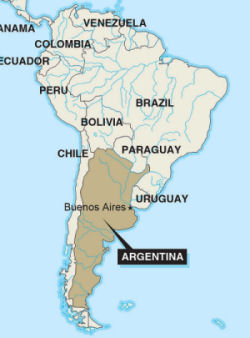 This lump comes to us from Argentina according to the Kamado Joe web site. For those of you who are
geographically challenged, we have conveniently provided a map of South America to the right which
shows the location of Argentina.
This lump comes to us from Argentina according to the Kamado Joe web site. For those of you who are
geographically challenged, we have conveniently provided a map of South America to the right which
shows the location of Argentina.
Kamado Joe Big Block lump is made from a blend of three different South American woods, According to one
of their ads on Amazon, the three species are Guayacan, Guayaibi, and White Quebracho. White Quebracho or
more correctly, Quebracho Blanco is widely used as charcoal, since it does not produce sparks
or large amounts of ash, and it burns strong and slowly. It is a very hard wood as evidenced by its
name "Quebracho" which translates to "axe breaker."
We had a little trouble running down the other two species. There are five species of Guayacan. We
suspect they are using Guaiacum officinale, common Lignum-vitae, as it is the only one of the five which
grows in South America. Guayacan is used to make mallets used by woodcarvers to hammer their chisels.
And as far as Guayaibi, we suspect they are using Cordia americana, commonly called
Guayaibi Blanco. Guayaibi is sometimes used to make baseball bats. So, all three types of wood are known to be hard as rocks.
And just for fun, here are some photographs of these three woods for you to enjoy:
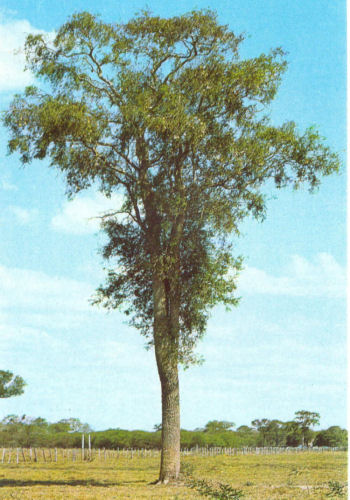 Quebracho Blanco Tree |
|
 Quebracho Blanco Log Cross Section |
| . | . |
 Guaiacum officinale Tree |
|
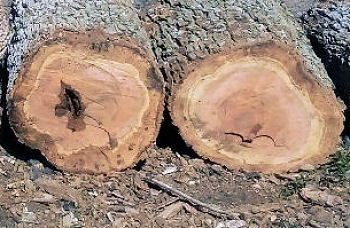 Guaiacum officinale Log Cross Section |
| . | . |
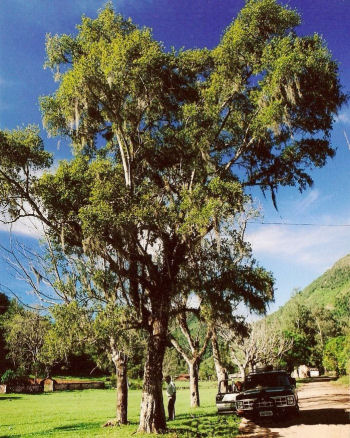 Guayaibi Blanco Tree |
|
|
But enough with the geography and botany. How does this blend of these three woods perform as lump
charcoal? First of all, let's take a quick look at the packaging. We ordered the charcoal from Amazon
and as you can see down below, it came in a bag that was contained inside of
a Kamado Joe Big Block box. The box was sturdy and the charcoal arrived in great shape. The bag itself
is rather interesting. We hope you can see in the following photo, that the bag is 4 layers. Working from
the inside to the outside, there is a layer of brown paper, a layer of plastic, another layer of brown paper
and then finally the outer orange paper layer which has the printing on it. We would think that the plastic
layer is going to prevent any issues with high humidity or other types of moisture short of total immersion.
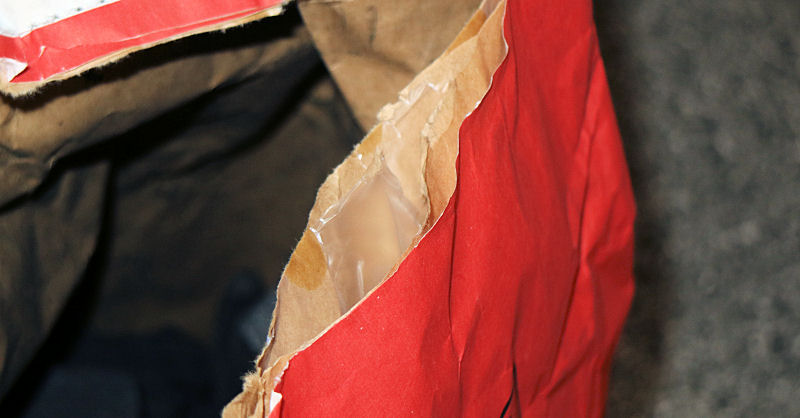
Next, let's take a look at the size distribution of this charcoal. Needless to say, the packing
indicates that you should expect some pretty large pieces of lump with phrases like "World's Largest",
"incredibly large" and "extra large." The bag is littered with references to large, XL, block etc.
Fortunately, the overall contents of the bag don't really turn out to be quite what the language on
the bag would lead you to believe. Why fortunately? Because contrary to what you see and hear a lot, huge logs
of charcoal really aren't that desirable. Big chunks don't burn longer. 3 pounds of charcoal is just
3 pounds of charcoal, whether it's in a few large blocks or a lot of little chunks, especially in
kamado-style cookers where the fire is contained and the airflow is controlled. And nothing but large
chunks doesn't make for very good low and slow fires. What is actually the ideal bag of charcoal is
a few large chunks, a lot of medium-sized chunks, and a minimal amount of small pieces, chips and dust. Which is pretty much what we got with this bag of
Kamado Joe Big Block lump charcoal. Take at look at the distribution of sizes:
| Large |
3.5 pounds |
17.2% |
| Medium |
13.6 pounds |
66.7% |
| Small |
2.5 pounds |
12.4% |
| Chips/Dust |
0.8 pounds |
3.7% |
|
|
|
| Total |
20.4 pounds |
|
In this photo down below of the bag sorted by size, you can see how small the amount of
smaller pieces and chips/dust was. As far as the quantity of chips and dust go, the 3.7% by
weight that we found was
very low compared to all brands we have tested. And in this photo you can see the largest
pieces in the bag, hardly the largest pieces we have ever seen.
Finally, we found no sawn pieces of lumber, no scrap wood, and no strange looking materials. We did find
almost ½ pound of uncarbonized bark, but all in all, we were very pleased with
what we got in this bag.
Next on to the lighting test, this lump took 5 sheets of newspaper to get it going, which is high compared
to all other brands. There was no sparking or popping whatsoever and the smell of the smoke was reasonably
mild, a typcial smell for South American hardwoods.
In our maximum temperature test, the charcoal was able to get up to 983°F, which is very high compared
to all other brands. There was no sparking or popping as the fire grew, and the fire spread at a moderate pace.
Again the smell was reasonably mild.
As far as burn time goes, Kamado Joe Big Block did reasonably well, just sneaking up into the high range compared
to all other brands. We light the charcoal for the burntime test with a MAP-Pro™ torch which is prone to
generating lots of sparks and popping. The amount of sparking and popping with this lump was
relatively low, but be sure to use caution if you use a torch for lighting your lump charcoal.
And finally, the amount of ash produced by this charcoal was only average compared to all other brands.
All in all, we really like this charcoal. Although the ash production and difficulty in lighting were nothing
to write home about, the burn time, maximum temperature and size distribution were all quite good. In fact,
as far as we are concerned, the size distribution was about as good as we have ever seen. We also like being
able to get this charcoal in boxes that protect the charcoal and are easier to store than just bags. So, we give this
charcoal our Recommended rating.

|
|
To the left is the rating that our readers have given this charcoal. If you have used this charcoal and would like to rate it and leave your comments, Click Here
To view reader ratings of all brands, Click Here.
|
|

